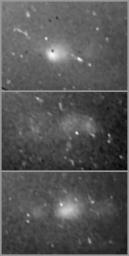NASA's Cassini spacecraft captured the first lightning flashes on Saturn when it captured these images on August 17, 2009.
NASA's Voyager mission and Cassini had previously captured radio emissions from storms on Saturn. Cassini scientists even nicknamed a band around the planet around 35 degrees south latitude "storm alley." The visible-light cameras aboard Cassini have been able to take pictures of bright, convective clouds over giant, powerful thunderstorms, including the famous "Dragon Storm" of 2004. (See PIA06197, PIA08411, PIA08410 and PIA07789.) But they were previously unable to get pictures of lightning flashing because the planet is very bright and reflective. Sunlight reflecting off the rings made the night side of Saturn as bright as a full-moon night on Earth. Equinox, the period around August 2009 when the sun shone directly over Saturn's equator and lit the rings edge-on only, finally brought the necessary darkness.
These images were obtained by Cassini's imaging science subsystem around 36 degrees south latitude and 11 degrees west longitude over a period of 13 minutes. The storm that generated the lightning lasted from January to October 2009, making it the longest-lasting lightning storm known in the solar system. Exposure times lasted about three minutes. Some of the spots in the image come from cosmic ray hits. The long exposure times on the camera and brightness processing increase the visibility of the cosmic rays.
These three images were taken in visible light with the Cassini spacecraft narrow-angle camera. The view was acquired at a distance of approximately 2.1 million kilometers (1.3 million miles) from Saturn. Scale in the original images was 24 kilometers (15 miles) per pixel. The images were re-projected to a simple cylindrical map projection.
The Cassini-Huygens mission is a cooperative project of NASA, the European Space Agency and the Italian Space Agency. The Jet Propulsion Laboratory, a division of the California Institute of Technology in Pasadena, manages the mission for NASA's Science Mission Directorate in Washington. The Cassini orbiter and its two onboard cameras were designed, developed and assembled at JPL. The imaging team is based at the Space Science Institute, Boulder, Colo.
For more information about the Cassini-Huygens mission visit http://www.nasa.gov/cassini and http://saturn.jpl.nasa.gov. The Cassini imaging team homepage is at http://ciclops.org.

 Planetary Data System
Planetary Data System












